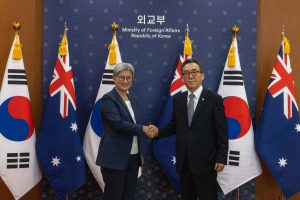This week, Australian Foreign Minister Penny Wong made an important three-stop trip to Laos, Japan, and South Korea on July 26-30. She attended ASEAN-related meetings in Vientiane while joining her U.S., Japanese and Indian counterparts at the eighth Quad Foreign Ministers’ Meeting in Tokyo. Finally, she held talks with South Korean Foreign Minister Cho Tae-yul on enhancing the Australia-South Korea Comprehensive Strategic Partnership (CSP), and also visited the U.N. Command Buildings in the Joint Security Area (JSA) within the Demilitarized Zone (DMZ).
Wong’s trips to Laos and Japan are not a surprise given that ASEAN-Australia celebrate the 50th anniversary of their dialogue relations this year and the institutionalization of the Quad is gaining momentum. But Wong’s activities in Seoul had noteworthy implications. The fact that she visited South Korea after attending the Quad Foreign Ministers’ Meeting in Tokyo has further underlined the importance of strong collaboration among democracies with shared interests and values.
For South Korea and the West, the term “Comprehensive Strategic Partnership” is highly sensitive now after Russia and North Korea concluded a CSP Treaty. Article 4 of that agreement states that both sides will “provide military and other assistance” in case Russia or North Korea is invaded by “an individual state or several states.”
By stressing its CSP with Australia this time, South Korea is sending a message to North Korea that it also has strategic alignments, beyond Japan-South Korea-U.S. trilateral cooperation, that are equally important as North Korea-Russia ties. Besides, by visiting the JSA within the DMZ, Wong highlighted Australia’s support for international cooperation in ensuring security and stability as well as showed solidarity with Seoul over concerns about North Korea.
Beyond its political significance, Wong’s trip to Seoul reflects closer cooperation between like-minded Indo-Pacific partners, progressing implementation of the outcomes from the two countries’ sixth 2+2 Foreign and Defense Ministers’ Meeting on May 1 in Melbourne. South Korea maintains regular 2+2 meetings with only two countries: its treaty ally the United States and Australia. The Melbourne Meeting was also the first since the inauguration of both the Yoon and Albanese governments and the announcement of South Korea’s Indo-Pacific Strategy.
From a broader perspective, the Cho-Wong talks represent the union of two middle powers to actively shape the regional architecture amid uncertainties. In recent years, diversifying partners with various countries has been a popular policy option among regional middle powers. In the case of Australia and South Korea, they are not only close partners and fellow U.S. allies but also middle powers who have considerable influence and resources in the region, sharing vision of regional and global affairs.
Now they need to foster their bilateral relations in preparation for possible upheaval in U.S. foreign policy. If Donald Trump is elected, his unpredictability can make South Korea and Australia worry about the enduringness of the Camp David trilateral cooperation agreement and the implementation of AUKUS, respectively.
There is also a growing convergence of strategic and security-defense interests between the two countries that brings them closer to each other.
First, they are key partners in advancing their respective Indo-Pacific strategies. Australia is South Korea’s largest trading partner in Oceania while South Korea remains among Australia’s top three largest trading partners and export markets. While exploring new cooperation agendas in areas like national defense, security, the defense industry, critical minerals, climate change response, and supply chains, the two countries are among the democracies closely working together toward maintaining the rule-based international order in the region.
Second, they can be ideal partners in arms procurement. As an emerging global arms exporter (ranked ninth), South Korea has advanced military technology that it can share with the AUKUS partners, including Australia. Also, as Australia is accelerating its defense buildup program, South Korea is a very promising partner for the country to purchase new weapons that are high quality but cheaper than U.S.-made ones. Selling arms to Australia can help South Korea achieve its aim to become the world’s fourth largest arms exporter by 2027.
Third, they can work closely in terms of AUKUS expansion. South Korea is among countries such as Japan or New Zealand who have recently expressed interest in joining the second pillar of AUKUS. Although Pillar I (regarding nuclear-powered submarines) is Australia’s primary focus, reaching other like-minded countries and cooperating with them in the high-tech areas of Pillar II is a supportive complement to help the Albanese administration build a “strategic balance” in the region: “where no country is dominated, no one country dominates, where we all have our sovereignty assured.”
As the world order has reached a tipping point under fierce pressure of major powers’ competition, it is natural for middle powers to avoid risks and uncontrollable changes by joining together. For Australia and South Korea, like-mindedness, shared viewpoints, and common values constitute a solid foundation for them to deepen bilateral ties. With increasingly overlapping interests in key strategic issues, their relations may grow even more vigorously in the post-Biden era.

































